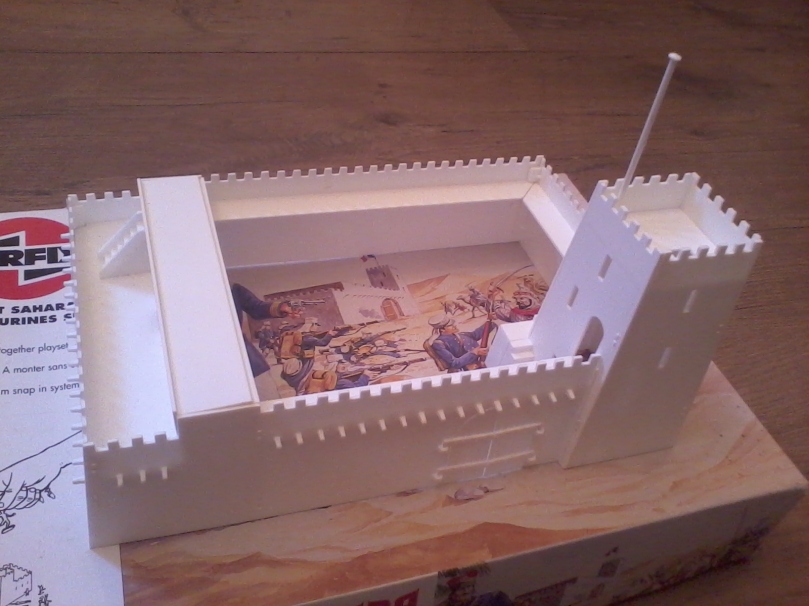It’s sometimes relatively easy to trace at least some of the childhood influences that led to taking up a hobby like wargaming. I was reminded about a couple of mine, recently, when a discussion cropped up in the pub (as it will) about remembering old television programmes.
I don’t know why English television during the late1960s and early 1970s imported so many French series aimed at children, dubbed them badly into English, and then broadcast them during every school holiday, over and over again. I’ll say now that one exception to the bad dubbing,The Magic Roundabout, was blessed with a splendidly surreal narration by Eric Thompson, but that stands out because it really was the exception to a rule.
The same few French (and I may be wrong here, but I am pretty sure they were all French) serials came back again and again. Belle and Sebastian, White Horses, and Robinson Crusoe were all school holiday staples – although the first two were commonly regarded as being “for girls” – to the point that, even now, I can clearly recall their theme tunes and even some of the lyrics that accompanied those tunes. This is not necessarily a good thing.
There were two other French serials that really stood out for me, though, and which I loved, and could watch however often they were broadcast – which, in the case of the second one, was I believe only once.
The Flashing Blade was a historical adventure set during a war between France and Spain in 1530. With the French-held fortress of Casal besieged by Spanish forces, the Chevalier Recci and his faithful servant, Guillot, set out to fetch help for the beleaguered French garrison, their adventures stretching across twelve episodes. Actually, thirteen episodes, as for some reason the last of them was never shown on British television.
https://www.youtube.com/watch?v=z-ZEDNkZ2L4
That wasn’t the only issue. At the time, of course, I had no idea that The Flashing Blade was set during the Second Mantuan War (1528-30), or that the Siege of Casal was a real historical event. Therefore it slipped my notice that while the story was set during 1530, the real-life Casal had been relieved from the Spanish siege in 1529. But I’m sure that, even if I had known, such historical inaccuracy wouldn’t have spoiled my enjoyment at the time. After all, how many children’s television programmes have landsknechts appearing in them?
Another French series that popped up on our television, and that I think had an influence on my evolution into becoming a wargamer, was Thibaud ou les Croisades, or in its slightly more prosaic dubbed-into-English form, Desert Crusader. As far as I know, this was only broadcast once, unlike those recycled holiday shows. Perhaps that has made it seem all the more precious in my memory, a dash of colourful mediaeval romanticism sandwiched between the other post-schoolday teatime children’s television shows like Blue Peter and The Doubledeckers, which seemed to me rather grey programmes in a grey world.
https://www.youtube.com/watch?v=Q22FxOdEYLc
I am reaching back through the haze of memory to write this, so I may be wrong, but as I recall the eponymous Thibaud was half-Saracen, which suggests there may have been some wider liberal message about race and religion, though frankly at the age of around twelve (I think) I was too taken with the aforementioned colourful mediaeval romanticism to notice.
It set my imagination afire, anyway. For some time, a lot of my games after watching Desert Crusader centred on the Airfix model of Fort Sahara, with a mix of Airfix plastic miniatures that could vaguely represent (to me, at the time, at least) the period of the Third Crusade; the Sheriff of Nottingham, Robin Hood, and Arabs sets. It so happened that the Arabs contained one figure that I always thought particularly looked like Thibaud himself, in his flowing white robes, and that’s the role it took in my games. In more recent times I re-acquired an Airfix Fort Sahara playset, including sprues of Foreign Legion and Arab miniatures, and was genuinely cheered to find that same “Thibaud” figure still included, even if he is now cast in orange rather than in his original white plastic form.

I’m pretty sure that both programmes could even now provide inspiration for wargaming. The Flashing Blade is available on a DVD (and yes, I do own a copy) that even includes the “missing” thirteenth episode. Sadly, I can’t find an English-language version of Desert Crusader, although all the episodes appear to be available on YouTube in the original, undubbed, French and under the original French title. I just wish my grasp of the French language was good enough to follow it!
